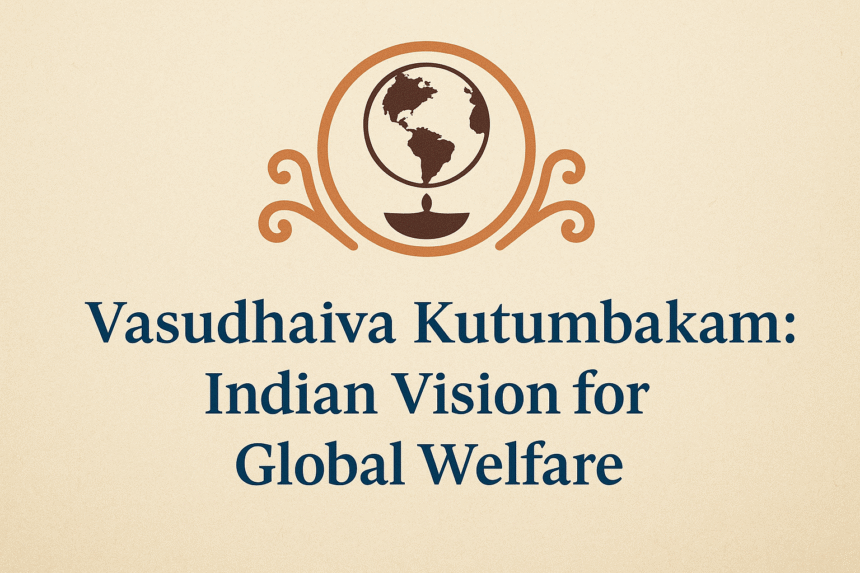Vasudhaiva Kutumbakam: Indian Vision for Global Welfare
Part 11: RSS Centenary Sankalp Blog Series
🇮🇳/🇬🇧
“Ayam Nijah Paro Veti Gananaa Laghuchetasam, Udaarcharitaanam Tu Vasudhaiva Kutumbakam”
“This is mine, that is yours, such is the calculation of small minds. For those of noble character, the whole earth is one family.”
Globalized World: Vasudhaiva Kutumbakam
This timeless verse from the Maha Upanishad forms the philosophical core of the Rashtriya Swayamsevak Sangh’s (RSS) Centenary Sankalp Patra. When the RSS marked its hundred years in Bengaluru 2025, the declaration was clear: “To build a harmonious and organized Hindu society for global peace and prosperity.”
The vision was not confined to India’s borders. It was an affirmation that the ancient ideal of Vasudhaiva Kutumbakam—the whole world as one family—remains the lodestar for the future of humanity.
Philosophical Roots of Vasudhaiva Kutumbakam
In earlier discussions, we have traced the spiritual foundation of Sanatana Dharma and its practical implementation through the Sangh’s centenary deliberations. Now, it is time to understand how these culminate in the broader ideal of Vasudhaiva Kutumbakam.
The Sankalp Patra reaffirms the eternal Indian idea of universal brotherhood: one consciousness dwelling in all beings, unity in diversity, and the recognition that personal well-being is inseparable from collective well-being. Unlike western frameworks rooted in markets or power, this vision sees the family as the natural metaphor for the world order.
Universal Brotherhood versus Western Globalization
Modern globalization has largely been shaped by western priorities—economic dominance, cultural homogenization, market relations, and a competitive mindset.
In contrast, Vasudhaiva Kutumbakam offers:
-
A sense of unity rooted in spiritual consciousness.
-
Respect for cultural diversity rather than its erasure.
-
Relationships built on familial trust and cooperation.
-
An ethos of harmony instead of rivalry.
Thus, what the West pursues as globalization, India presents as humanization.
India’s Role in Global Peace
In the Sankalp Patra, the commitment to “world peace and prosperity” gives Vasudhaiva Kutumbakam a central role. India’s civilizational emphasis on ahimsa (non-violence), dialogue, and mutual understanding provides a model of conflict resolution.
Whereas violence is often the first resort elsewhere, the Indian tradition views war as the very last option, after every avenue of dialogue and respect has been exhausted. This philosophy is not an abstract ideal but a practical contribution to international disputes and peace-making.
A Model for Economic Justice
The centenary declaration also links material prosperity with spirituality, presenting Vasudhaiva Kutumbakam as an economic principle. It calls for local production with global reach, equal opportunity for small entrepreneurs, balanced development with nature, and just distribution of wealth.
This is not charity but cooperation: sharing technology freely, using natural resources responsibly, ensuring trade is mutually beneficial, and extending unconditional assistance to developing societies. In this model, growth is not the privilege of the few, but the right of all.
Environmental Harmony as Global Responsibility
In the Sankalp Patra, “an eco-friendly lifestyle” reflects India’s traditional reverence for nature. In Hindu thought, nature is not an object of exploitation but a living presence—rivers as mothers, trees as divine, the five elements as sacred.
India’s leadership in solar energy, water conservation, organic farming, and the International Solar Alliance exemplifies how Vasudhaiva Kutumbakam translates into global environmental policy. It is an approach where simplicity, gratitude, and balance guide human action.
Yoga, Ayurveda, and Holistic Health
The global recognition of Yoga and Ayurveda is another dimension of this vision. Yoga is now acknowledged worldwide as a science of body and mind, while Ayurveda offers a preventive, natural, and balanced model of health.
From International Yoga Day to the revival of Ayurveda in modern medical research, India’s contribution is not nationalistic pride—it is the sharing of heritage for the health of the global family.
Diaspora and Cultural Ambassadors
The Indian diaspora embodies Vasudhaiva Kutumbakam in action. Across the world, they carry Indian values into local societies, balancing professional success with cultural identity. Festivals, traditions, and community organizations abroad serve as bridges between India and host nations.
The Sangh’s vision also extends through branches that nurture Indian samskaras among children, foster goodwill with local communities, and celebrate cultural unity.
Knowledge Sharing and Education
A vital feature of the centenary vision is the spread of ancient knowledge. Sanskrit, philosophy, mathematics, astronomy, and architecture are not relics of the past but living contributions for the modern world. Through exchange programs, joint research, and international collaborations, India seeks to make this wisdom accessible globally.
Cultural Diplomacy and Soft Power
Indian culture—whether through classical music, dance, cuisine, or cinema—has become a gentle force of influence. Unlike coercive cultural export, this soft power stems from shared joy and participation. Temples, pilgrimage centers, and yoga ashrams attract not just tourists but seekers of truth and peace.
Global Hindu Networks and Interfaith Dialogue
The centenary vision emphasizes that Hindu society must organize itself globally, through institutions like the Vishva Hindu Parishad, which connects Hindus worldwide, protects cultural heritage, and advocates for freedom of conscience.
At the same time, Vasudhaiva Kutumbakam provides the basis for interfaith dialogue—developing shared values, resisting extremism, and spreading a message of peace and tolerance.
Technology, Innovation, and Global Cooperation
India’s technological contributions—digital payments, low-cost space solutions, identity systems like Aadhaar—are practical expressions of the global family idea. They show how innovation can be shared with less privileged nations, reinforcing cooperation instead of dependency.
Through scholarships, training, and South-South collaboration, India positions itself not as a power center but as a partner.
Contemporary Challenges and India’s Response
Terrorism, pandemics, and gender inequality are pressing issues of our times. The RSS Sankalp Patra places Vasudhaiva Kutumbakam at the heart of the response: defining terrorism clearly, cutting off its financing, ensuring vaccine equity, and promoting women’s empowerment through an Indian model rooted in dignity, family, and strength.
Youth, too, are seen as global leaders. With Indian CEOs in Silicon Valley, athletes on world stages, and scientists in global research, the younger generation carries the flame of Vasudhaiva Kutumbakam into the future.
Toward a World Family
As the series began with the prayer “Sarve Bhavantu Sukhinah”—may all beings be happy—it now finds completion in the centenary Sankalp Patra of the RSS. Vasudhaiva Kutumbakam is not about India competing with ideologies or imposing itself upon the world. It is about living an ancient truth in a modern age.
It is the conviction that the world’s well-being is inseparable, and that India’s duty is to share—not dominate, but to guide with compassion, harmony, and strength.
Thus, the centenary vision is not a celebration of India’s past alone, but a pledge to the future: that the whole world may truly live as one family.
Feature Image: Click here to view the image.
हिंदी वीडियो
English Video
Glossary of Terms
-
Vasudhaiva Kutumbakam: A Sanskrit phrase from the Maha Upanishad meaning “the world is one family,” emphasizing universal brotherhood.
-
Maha Upanishad: An ancient Hindu text where the foundational verse of Vasudhaiva Kutumbakam is found.
-
Rashtriya Swayamsevak Sangh (RSS): A Hindu cultural organization founded in 1925, marking its centenary in 2025 with a Sankalp Patra.
-
Sankalp Patra: The centenary declaration or pledge of the RSS, outlining its vision for global peace, harmony, and Hindu unity.
-
Ahimsa: The principle of non-violence central to Indian civilization and reflected in RSS’s global peace vision.
-
International Solar Alliance: A global initiative led by India to promote solar energy cooperation among nations.
-
Ayurveda: India’s traditional system of holistic medicine, promoting balance and natural healing.
-
Vishva Hindu Parishad (VHP): A global Hindu organization working to connect Hindus, preserve culture, and advocate for freedom of conscience.
-
South-South Collaboration: Cooperative initiatives between developing nations, often led by India, to share resources, knowledge, and innovation.
-
Sarve Bhavantu Sukhinah: A Vedic prayer meaning “may all beings be happy,” symbolizing the universal welfare ethos.
#RSS100Years #VasudhaivaKutumbakam #GlobalPeace #HinduinfoPedia #SankalpPatra
Previous Blogs of the Series
- https://hinduinfopedia.org/sarve-bhavantu-sukhinah-the-spiritual-foundation-of-rss-philosophy/
- https://hinduinfopedia.org/pledge-for-the-world-the-vision-of-a-harmonious-and-organized-hindu-society/
- https://hinduinfopedia.org/centenary-resolution-from-shakha-expansion-to-social-transformation/
- https://hinduinfopedia.org/striving-for-character-excellence-enhancing-shakha-quality/
- https://hinduinfopedia.org/organizing-noble-people-power-of-social-transformation/
- https://hinduinfopedia.org/social-metamorphosis-from-values-to-culture/
- https://hinduinfopedia.org/panch-parivartan-the-five-dimensional-transformation/
- https://hinduinfopedia.org/spiritual-foundation-power-of-sarve-bhavantu-sukhinah/
- https://hinduinfopedia.org/from-struggle-to-solution-facing-modern-challenges/
- https://hinduinfopedia.org/from-planning-to-reality-practical-implementation/
Related Blogs
- https://hinduinfopedia.org/rashtriya-swayamsevak-sangh-a-pillar-in-modern-hindu-society/
- https://hinduinfopedia.org/sanatana-dharma-secular-and-inclusive-values-of-hindu-philosophy/
- https://hinduinfopedia.in/nathuram-godse-murderer-patriot-or-fractured-youth/
- https://hinduinfopedia.org/ambedkars-buddhist-political-move-divergence-from-gandhi-on-caste-issues/
- https://hinduinfopedia.org/india-china-border-tensions-a-strategic-analysis/
- https://hinduinfopedia.in/gandhis-murder-was-nehru-involved/
- https://hinduinfopedia.in/waqf-act-debate/
- https://hinduinfopedia.com/abrahamic-religions-alliance-how-global-networks-target-indias-democracy/#Modi_the_RSS_and_the_Abrahamic_Narrative_Trap



Leave a Reply